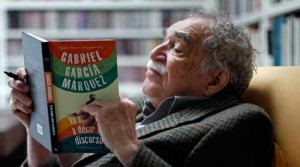 By Raymond L. Williams, New America Media
By Raymond L. Williams, New America Media
Colombian writer Gabriel García Márquez, the inventor of the mythical town he called “Macondo,” has passed away at the age of 87. Journalists loved him for his ability to spontaneously produce catchy one-liners in interviews. The general reading public adored him for his entertaining and engaging stories so related to their own real experience. Academics have been fascinated to speculate on the meaning of such oddities as abundant yellow butterflies, old men with inexplicably long wings, or the very best definition of his trademark “magic realism.” As an academic who decided in the 1970s to launch a career researching the unlikely and then relatively obscure subject called “Colombian literature,” I always benefited from the anchor of at least one accomplished Colombian writer widely recognized beyond that nation’s borders.
Who was this man whose “Macondo” seems so exotic yet at the same time so close to so many lives?
My first image of the writer dates back to when the then 48-year old emerged from the elevator in the lobby of the Hilton Hotel in Bogotá, October of 1975. Already rich and famous from the 1967 publication of the best-selling novel One Hundred Years of Solitude, he had just arrived from Barcelona a few months after publishing the novel The Autumn of the Patriarch. A mutual friend (the Colombian critic from Barranquilla Néstor Madrid-Malo) had arranged for me to meet the writer in the hotel lobby, where I was immediately struck by the stark contrast between everyone else in that lobby—wearing elegant dark suits and ties—and the visibly informal García Márquez, who was wearing blue jeans and a colorful shirt. The straight-forward, no-nonsense and absolute clarity of the conversation in his room, centering on this complex novel The Autumn of the Patriarch, left a lifetime impression on me. I’ve met other accomplished creative writers in my career, but few others have approximated García Márquez in the simplicity and clarity of what was his genius: finding the magic in the things of everyday life.
Eventually, as a specialist in what was this still academically dubious field called Colombian literature, I found myself writing a book on the work of García Márquez, starting in early 1982 and then–with a stroke of serendipity—found myself finishing it on a writer now awarded the Nobel Prize for Literature in late 1982. Suddenly, my book had far more relevance than might have been the case otherwise. For me, however, reading García Márquez has always been a much more satisfactory experience than writing about his work. With this writer, I tend to resist interpretation for he seems to be so over-interpreted: why not let those yellow butterflies just inhabit Macondo rather than insist on dissecting them? Struggling through that first book on the Colombian writer and reading of his work in the process, however, clarified a lot, including the following: the writing of García Márquez is really about how the common people—the pueblo of the impoverished Caribbean coast of Colombia—not only survive but find ways to live with dignity.
I do not want to simplify this writer’s complex work too much by claiming it was only about survival and dignity. This was, however, a constant theme in much of his work, and this was the feature that made the Colombian so appealing world-wide. That down-to-earth 48-year-old pre-Nobel García Márquez was a man of total integrity: he not only talked-the-talk, but he walked and wrote the talk of the supreme value of common lives and everyday things.
Over the course of an increasingly viable academic career centered on “Colombian literature,” I spoke with the post-Nobel García Márquez at the ages of 58 (in Cartagena) and 60 (in Mexico City). Now even more of a celebrity public intellectual, he was still alarmingly simple in his genius. He was one of the few writers, for example, whose speech patterns are similar to his writing style.
In a dinner conversation among writer friends in Cartagena in 1993 (age 66) he stated that the one book that he wished had written himself was Juan Rulfo’s Pedro Páramo. Years before, he had claimed to a journalist that his best book was No One Writes to the Colonel. What these two brief novels have in common is both their brevity and the simplicity of the language.
In a complex technological, globalized and postmodern 21st century, García Márquez invited all his readers to appreciate the special qualities (or magic) of the commonplace, to revere simplicity, and to celebrate the human spirit. This attitude toward the world placed not only his work on the world map, but the entirety of a nation and its literature in the consciousness of the world community. His attitude, as well as his spoken and written words, represented a life and a writing practice of admirable integrity.
Raymond L. Williams has published books and articles on Colombian and Latin American literature.His most recent book is A Companion to Gabriel Garcia Márquez (Tamesis, 2010). He holds the title of Distinguished Professor at the University of California, Riverside.








